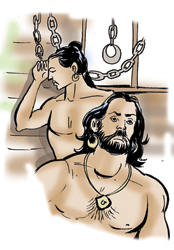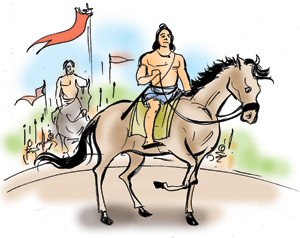1. The uprising against King Buwanekabahu VI is termed as the 'Revolt of the Sinhala People' in the Rajavaliya. The Dedigama inscription makes mention of a rebellion named 'Sinhala Sange.' However, there is reason for this. The king's father did not belong to a Sinhala clan. Because of this, many people did not accept Buwanekabahu, as a Sinhala king. Those were the people who were more patriotic.
2. The king sent his younger brother,
Prince Ambulugala with the army of the
Four-Korale, to suppress this rebellion. This prince marched forward and set up camp in Pasdun Korale. He somehow took all the necessary steps to see that the rebellion did not spread. The two rebel leaders were arrested and brought to Kotte. King Buwanekabahu imprisoned these leaders. This shows, that the king had some kind of sympathy for them.
3. It was around
1476 AD, that this revolt arose and then it was not even six years after the coronation of this king. A team of envoys from Pegu visited Lanka, during this time. They had landed in Weligama. The rebels who were there, obstructed them from coming to the capital city. The king's army succeeded in
suppressing the rebellion.
4. When Prince Ambulugala was in Pasdun-Korale, there too, there was a revolt against the king, who was ruling under him. The king had to march to put down this rebellion too. The king successfully put down the rebels and got engaged in a friendly dialogue with the rebel leaders. They were finally
pardoned. There arose trouble in another area.
5. These little uprisings would have resulted due to the kindness of King Buwanekabahu.
In the document where the king's pardon is stated, there are facts which had not been settled till then. Among these there is one
mention of an attempt made by a prince named 'Senasammatha' Vickramabahu,' under whose leadership the Kandyan provinces had gained independence from the Kotte Kingdom. However, there is no
mention of the background of this prince.
6. The honorary name 'Sena Sammatha,' gives a clue as to how he came to power. Going by the inscriptions, this prince had adopted the honorary name 'Chakravarti.' The aspirations of this prince was not a kingdom limited to the Kandyan provinces. He has put up an
inscription where he says he pardoned the people of the four Korales.
7. In this inscription is included a statement which gives a promise made by the people, to the effect that they would be supportive of him. However, it is not quite definite, whether this pardon is one given before the pardon given by King Buwanekabahu as some scholars believe. Some are of the opinion that Prince Vikramabahu was once the 'Yuvaraja' of the King Buwanekabahu of Kotte.
8. The prince had brought the four Korales under him. It is evident that the prince would have had high hopes of annexing the Kotte Kingdom too. But King Buwanekabahu
succeeded in winning back the four Korales. |



